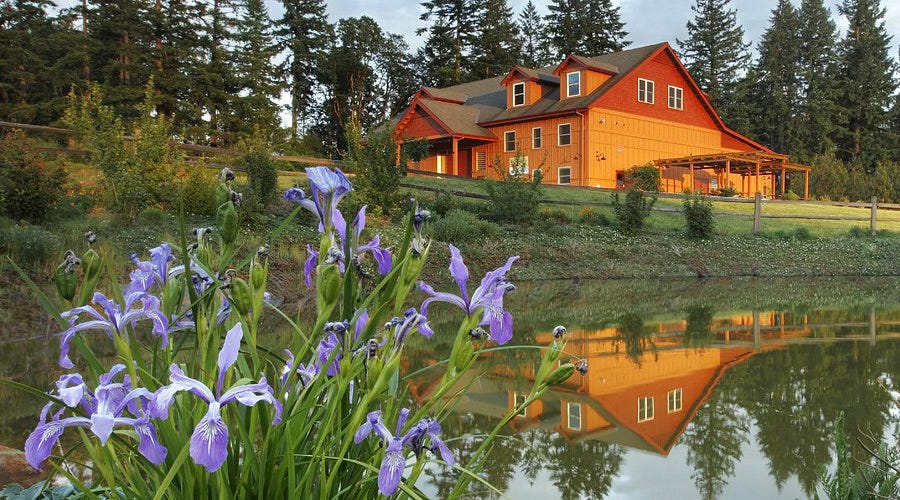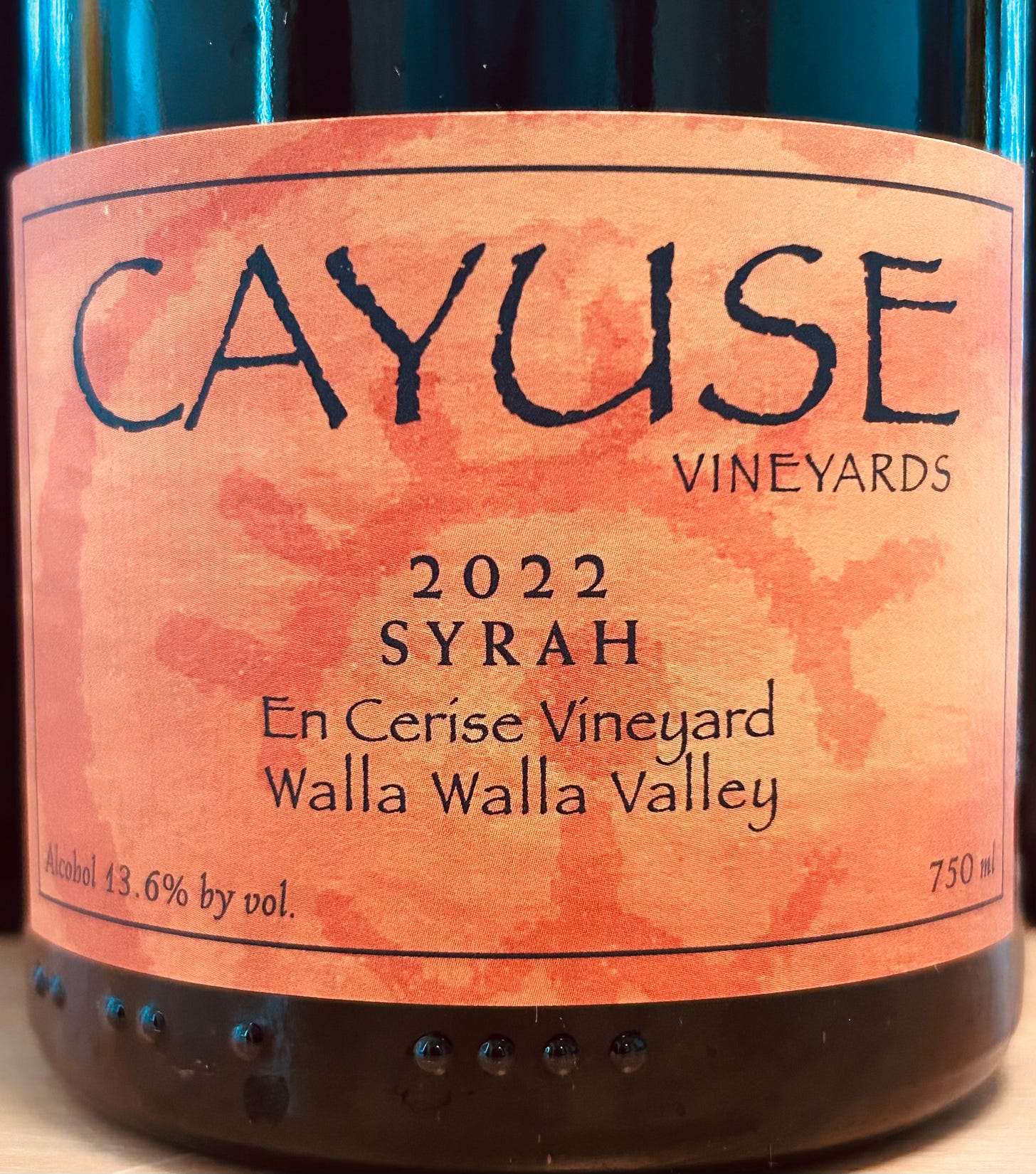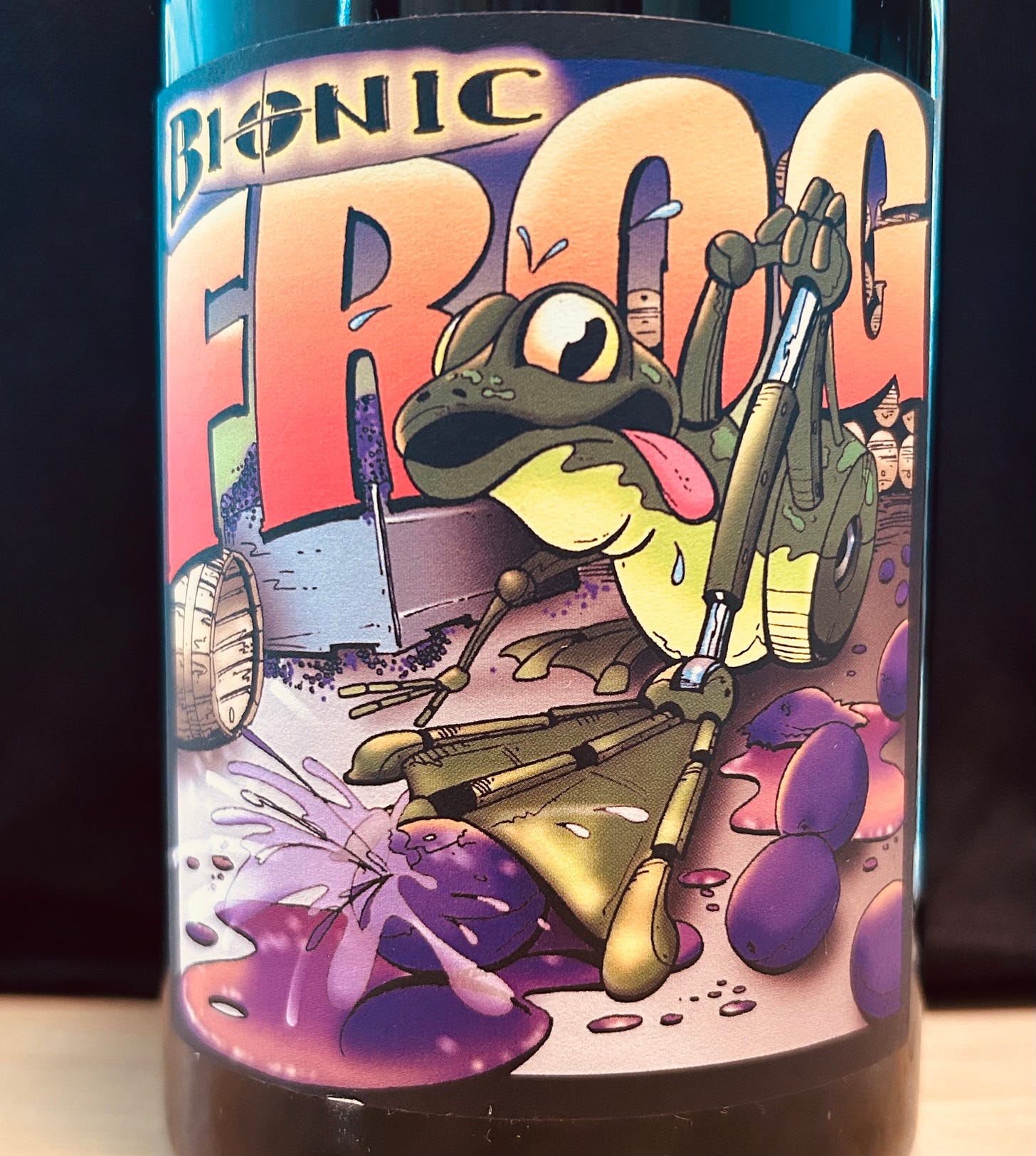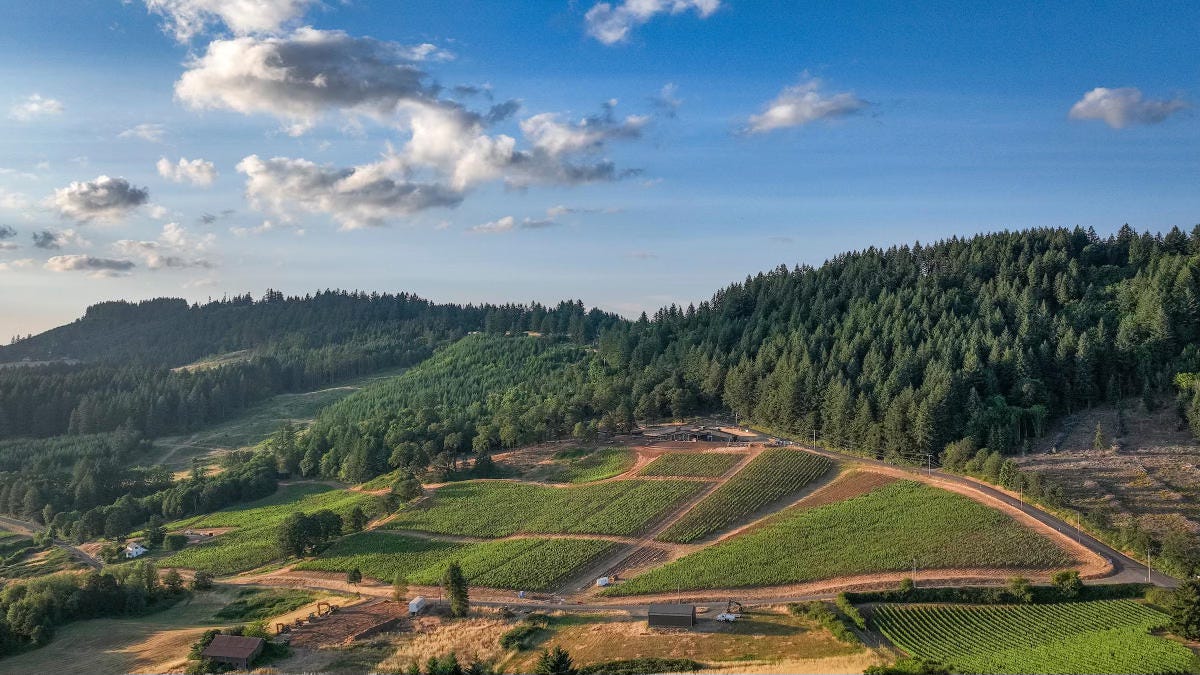Rock Around The Block? The Logic Behind Single Vineyard Block & Clone Selections
Featuring new releases from Cayuse, Jachter & Winter’s Hill
One of the ways in which Oregon’s winemakers are putting their imprint on longstanding, old world winemaking practices is by offering multiple selections of Pinot Noir from a single vineyard in the same vintage. Many varietal wines come in different single vineyard versions; there are also tried-and-true ways to differentiate among cuvées by designating some as reserves or barrel selects, old vines etc. But with Pinot Noirs any number of offerings may be separated by the name of the clone or a particular vineyard block. I’ve seen as many as six Freedom Hill wines from Patricia Green, and as many or more from Shea. Why do wineries do this, and how can you as a consumer relate?
When I first began noticing this trend about 15 years ago I was not a believer. In many instances I’d taste a half dozen wines from the same producer – a Block 1-B here, a Dijon 114 there, and so on, and when all was said and done it was the blended wine, often the least expensive wine of the group, that showed best. How were consumers supposed to choose among so many options about which they knew nothing? The wineries rarely if ever provided any helpful details. A graphic of the vineyard with Block Whatever outlined didn’t really shed any light on anything. And unless you have the opportunity to taste single clones of Pinot Noir frequently it’s not all that easy to tell them apart. It seemed confusing and even a little lazy – why put together a complex blend when you could just bottle each component separately? And charge more for it!
That’s the cynical point of view, and over the years I’ve come to appreciate, more often than not, that with Pinot Noir in particular such block and clone distinctions can be valid, and add another dimension to the never-ending process of individual palate development. The key for me when tasting such a lineup is that the wines must satisfy three essential requirements: 1) they must be identifiably unique one from another; 2) they must be complete wines as stand-alone bottles, rather than blending components with a missing piece or two; and 3) they should be comparable in terms of overall quality and interest to the winery’s blends from the same vintage.
I was chewing on such thoughts as I was tasting a selection of new releases from Winter’s Hill, one of the quiet, hardworking and often uncelebrated wineries in the Northwest doing steady, reliable, often exceptional work. The winery property was purchased in 1961 by John and Lena Winter, but it wasn’t until 1990 that their daughter Emily and her husband Peter Gladhart planted the first vines. Now the property is under the care of their son Russell Gladhart.
I learned this week that Peter Gladhart had passed away. I’m sorry that we never met, and though it’s sadly too late, I want to celebrate his vineyard, his wines and his family’s ongoing contribution to the growth of Willamette Valley wine. One of a small number of wineries in the heart of the Dundee Hills, where David Lett first planted his vines, Winter’s Hill is a treasure to be enjoyed and appreciated.
Chris Lubberstedt is now the Associate Winemaker, and was kind enough to answer some questions that popped into my head after tasting a group of wines sourced from the estate vineyard’s 2022 crop. Among the five were an entry-level blend, a mid-priced blend, and three from their ‘Single Block Series’ that featured specific clones (another wine – Block 8 – was not tasted). This group satisfied the three requirements listed above, so I turned to Chris for his thoughts.
PG: What is your specific role at the winery?
CL: “I am driving the winemaking, implementing some new strategies, and providing a fresh perspective. No major shifts in the house style. Russell and I have very similar winemaking views and palates. He is still 100% involved in the winery, very much as GM. He is especially involved on the vineyard side, and interacts with our full-time vineyard manager, Luciano Reyes.”
PG: When and how did the Single Block Series debut?
CL: “2012 was the first vintage for the series [prior to Chris joining the team]. They started bottling some of the blocks separately because they wanted to show the differences they were tasting in the cellar. As the estate vineyard got older, more block and clonal variation was expressed in the wines, and as an 100% estate brand, they wanted to share that with their customers.”
PG: How do these wines impact the blended wines? Which come first, the blends or the single selections?
CL: “The strategy we apply is tasting through the cellar by fermentation lots, a month after ML completion. This first pass is more for QC [quality control], but favorites will start to shine. In May, Russell and I will taste through those lots again with an intention of identifying single block contenders, and exceptional single barrels/puncheons. At the same time those blocks are chosen, we will also select a few individuals for the Reserve blend. Following that, we are able to glean out some of the remaining for the Dundee Hills. What remains is the Watershed blend.”
PG: What are the strengths or advantages of single block/clone wines? Are they easier to produce? How do your clients and tasting room visitors feel about them?
CL: “Russell has a great saying that ‘the fermentation lots are a meritocracy’. We don’t intentionally handle the lots differently, in terms of a predestined bottling classification. Not that there is any block or lot that is easier to produce, but historical experience offers some insight into what might be expected from the lot, or what winemaking decisions to anticipate. The Single Block Series wines are a key part of the wine club allocations. Every year we have a multi-weekend opportunity for club members to taste these wines as a comprehensive barrel sample and buy them as futures. Once they have gone out in the club shipments any remaining wine is available for tasting and purchasing through the tasting room. Most common, the customers will identify with the individuality of the block wines compared to the Dundee Hills. They don’t tend to rank choice the differences between the block wines.”
PG: Is it possible that such wines add another layer of confusion or snobbery to consumers trying to further their interest in wine?
CL: “We don’t think so, and in a way they simplify the wine/vineyard experience. These wines are sold in the tasting room, so there is the real advantage of educating and describing to the customers that these wines are coming from ‘that vineyard block over there’. It is a very tangible way for us to tell the story of a wine’s sense of place, and then the wine must be up to delivering the message with personality. Part of the presentation is to acknowledge tasting the difference between blocks, tying the story back to clones and micro-climates and site aspect, etc. Deliberately not using ‘terroir’ here because I see that as a gateway word to confusion and snobbery.
“Something that came up while Russell and I were discussing this topic was the vineyard designate wine. If a winery buys fruit from Vineyard X, they are typically getting a single block, vineyard pick. They’re not splitting up the pick dates with multiple block selections, generally. So, especially in larger vineyards with multiple winery buyers, each of those wines are block designates as well. Wines labelled by block or clone aren’t a new level of complexity for the consumer, it has been an underlying character in the story all along.”
PG: Thank you Chris for these thoughtful insights. As I noted, Winter’s Hill is a bit of a hidden gem among Dundee Hills wineries. All of these current releases are well made and recommended.
Winter’s Hill 2022 Watershed Pinot Noir – For estate-grown, Dundee Hills Pinot Noir, this is a fine value. A lovely plum flesh color, it’s fragrant with an appealing mix of clean earth, rose petals and candied raspberries. Aged in neutral French oak, it’s light, elegant and fresh, with firm tannins putting a wrap around the brambly berry fruit. Even better after 24 hours. 480 cases; 13.4%; $34 (Dundee Hills) 91/100
Winter’s Hill 2022 Pinot Noir – Looking at the color this seems to be advancing quickly down an aging curve, though it’s drinking quite nicely now and isn’t due for release for another year. (It seems to me that it could come out sooner.) It’s an elegant, concise and nicely focused wine, somewhat along the lines of a young Eyrie Pinot, and will require aeration to open fully. Details of clean straw, mountain raspberry and a lick of caramel carry it through a mid-length finish. 269 cases; 13.7%; $49 (Dundee Hills) 92?/100
Winter’s Hill 2019 Reserve Pinot Noir – Hat’s off to Winter’s Hill for making a reserve that isn’t based simply on being big. Held back an extra couple of years after bottling, this three barrel reserve is restrained, elegant and detailed. It definitely needs decanting as it didn’t begin to really show itself until the second day, when the tannins firmed up and more savory elements emerged around red and purple fruits, sassafras, a streak of root beer and a hint of lemon oil. As with all the Winter’s Hill Pinots, there’s a well-built, well-balanced foundation of clean earth. 70 cases; 12.9%; $65 (Dundee Hills) 93/100
Winter’s Hill 2022 Single Block Series – Block 9/Clone 114 Pinot Noir – This spotlights the Dijon 114 clone, providing freshness and focus to the delicious berry and cherry fruits that power it. Fermented with 50% whole clusters, it’s a gift to fruit lovers such as me. Along with the rich fruits there’s a wash of sassafras and a dash of sandalwood, suggesting time in some new barrels. Focused and precise, it’s well worth its selection for this single block series. 100 cases; 13.7%; $59 (Dundee Hills) 92/100
Winter’s Hill 2022 Single Block Series – Block 9/Pommard Clone Pinot Noir – Aromatic and welcoming, this adds to the Block 9 series with a big burst of blackberry and black cherry fruit, peppery spice, an earthy base and full-bodied, ripe tannins. Details of chocolate and black tea enhance the finish. Tight when first opened, it will respond beautifully to aeration. Due for release this fall. 124 cases; 13.7%; $59 (Dundee Hills) 92/100
Winter’s Hill 2022 Single Block Series – Block 9 Center Cut Pinot Noir – This spotlights a section of the vineyard with Dijon clones 114 and 115, harvested together and co-fermented. The separate distinctions among this new block series are there to be found if you dive deep, and that is what makes Pinot Noir such a fascinating grape. In Burgundy the focus is on slight differences in terroir; in Oregon it’s the clones that are often the most distinctive. The core of ripe fruit mixes red berries and plums, light barrel spices and again a foundation of clean earth. Well-structured, firm and slightly salty, this is a wine that should evolve beautifully over the next decade. 100 cases; 13.9%; $59 (Dundee Hills) 93/100
Tomorrow, April 4th, kicks of what is known around here as Cayuse weekend. It’s the one weekend each year that Christophe Baron opens his winery to mailing list members to pick up wines, taste upcoming releases, and mingle with the winemaker and their fellow Cayusians. In advance of this I’ve been tasting through and featuring the expansive lineup of wines under the various Bionic Wines labels. I’ll conclude with these classic Cayuse Syrahs that started it all almost three decades ago (plus one rare and magical Viognier).
Cayuse 2023 Cailloux Vineyard Viognier – A rare glimpse at a Rocks District white wine, the purity of this 100% Viognier is remarkable. Without being over-extracted it offers a concentrated, distilled down to the basics example of the grape. From the aromatics on through the long finish it brings floral and citrus scents and flavors to the forefront, with sassy acids as a foundation. The typical botanical notes are here in abundance, and the overall balance – not too green, not too ripe, not too much alcohol, no hint of bitterness – puts the final polish on the finish. 153 cases; 13.5%; $78 (Walla Walla Valley) 95/100 (preview – October ‘25 release)
Cayuse 2022 Armada Vineyard Syrah – A pleasant aroma of blackberries and coffee grounds greets the taster, followed up with a mixed palate of earth, soy, peat, breakfast tea and (way in the background) blackberry pie. Nicely balanced and full across the palate, the Armada is never the most stylish or definitive bottling among the Cayuse Syrahs, but serves as a middle-of-the-road representation of the strengths and style of the entire portfolio. Smooth, supple and rounded after being open a full day. 635 cases; 14.2%; $109 (Walla Walla Valley) 94/100
Cayuse 2022 Cailloux Vineyard Syrah – Lush with a beautiful balance of the earthy terroir, fresh-picked strawberries, coffee grounds, green olives, capers and a briny substrate with a hint of dill. There’s a freshness driven by a streak of acid running through the core. This expands quickly once opened, meaning it’s fine for immediate enjoyment, and it brings a richness to the full palate almost immediately. The length and balance are right where they should be. 870 cases; 13.8%; $99 (Walla Walla Valley) 95/100
Cayuse 2022 En Cerise Vineyard Syrah – Over many years and many bottles the En Cerise has always been at or near the top of the Cayuse Syrah pantheon for me. It seems a bit softer, less jangly, more fruit-driven than some of the others, and here again it seems especially accessible. This is a pretty wine, layered with cherries, peat, coffee grounds, salami, black tea, olives – hell, it’s a one bottle picnic – it soaks the palate with complex flavors and lingers gracefully over literally minutes. The moderate abv is a plus. 397 cases; 13.6%; $99 (Walla Walla Valley) 96/100
Cayuse 2022 En Chamberlin Vineyard Syrah – Beautifully structured, steely, vertical and stacked. Unpeeling the layers is time-centric: decant, aerate, be patient. This is like your brand new memory foam mattress topper. Give it at least 24 hours to expand. Cranberry, funky earth, cured meat, black tea – the usual suspects. But here they are polished, stacked and detailed with chicory coffee as it trails out. 449 cases; 14.1%; $99 (Walla Walla Valley) 96/100
Cayuse 2022 Bionic Frog Syrah – This is what might be considered the old vine bottle from Cayuse. The grapes date from the earliest planting in 1998, and deliver the depth, texture, detail and yes, elegance, that can be found in vines of a certain age – when they are the right vines planted in the right place of course. This isn’t struggling to be what it is, it isn’t pushing you or shouting at you. It’s almost a finesse wine at this point, though still young, compact, brambly and loaded with earthy components. It smoothes out over hours and days, retaining its layered depth and long lasting finish. Surely a 10-year wine, maybe considerably longer. 535 cases; 13.6%; $135 (Walla Walla Valley) 97/100
I profiled Jachter wines last year. Here are the excellent new releases. Jachter is a great choice for anyone touring the northern Willamette Valley.
Jachter 2022 Raindance Foothills Vineyard Chardonnay – This young vineyard, planted in 2016 to Dijon 76 vines, is off to a great start under winemaker Jared Etzel. Following up the excellent 2021 vintage is this lively, fruit-driven, virtually irresistible wine. A bright straw color, with vivid acid underscoring fresh apple, lemon and grapefruit flavors, it glides across the palate and into a long finish that gathers strength as it trails out. There’s a mineral, wet stone lick resonating through the finish. 265 cases; 12.5%; $48 (Chehalem Mountains) 93/100
Jachter 2022 Raindance Foothills Vineyard ‘The J Reserve’ Chardonnay – Sourced from the same vineyard as the non-reserve bottling, this is quite similar and every bit as good. Does it separate out from the other wine? They show identical abv and barrel time, with no indication that the reserve got more new oak. It does offer more texture, concentration and minerality when you give it a good deep dive. 90 cases; 12.5%; $80 (Chehalem Mountains) 93/100
Jachter 2022 Pinot Noir – This single vineyard selection is bursting with spicy red fruits. Ten months in barrels (some new) adds a hint of peppery cinnamon. Aromatic and delightfully full-bodied through the mid-palate, it brings out Bing cherry and red plum as it breathes. This is a robust, expressive wine with medium term cellar potential; it should be hitting its best drinking window in the early 2030s. 13.4%; $48 (Chehalem Mountains) 92/100
Jachter 2022 Cuvée Karen Ann Pinot Noir – The Case vineyard is the source of this all-Pommard reserve bottling. Strawberry and cherry fruit is threaded with Dr. Pepper flavors, and maybe a hint of cola. There is a broad mid-palate that brings on baking spices and peppery candy. Though immediately front-loaded delicious, it’s got the stuffing and detail to evolve in the cellar over another decade or so. 125 cases; 13.5%; $80 (Ribbon Ridge) 93/100
Jachter 2021 Pinot Noir – This Ribbon Ridge cuvée pins the alcohol at 14%, making this a robust expression with deep fruit flavors in the core. Lush, pure black cherry fruit swamps the palate, trailing off with a lovely frame of baking spices and an assortment of nuanced highlights – caraway, coffee, sandalwood and caramel. The vineyard source is not named but… Jared Etzel is the winemaker. What top tier vineyards might be sourced from Ribbon Ridge? Make a guess. 93 cases; 14%; $65 (Ribbon Ridge) 95/100
Music Update – I have set up a music site on Bandcamp with recordings of original songs from my decades as a singer/songwriter. I’ll be adding material on an ongoing basis. I promise this is not another plea for financial support. I don’t even have that part of the website activated. I’m looking for ears, not dollars. If you are a musician and want to record any of this material, give me a shout and we’ll figure it out.
Note to Wineries – Wines sent to me for review can come from many sources – winemakers, tasting room managers, winery sales reps, outside marketing companies and others. If you are the person tasked with sending wines to media, please let everyone connected to your winery know when they were sent to me, and encourage them to subscribe to this Substack. I do not send out alerts when reviews are posted. So please subscribe, and when your reviews are published you will be sure to see them.








Hi Paul - I visited Winter's Hill in 2006 before I moved to Oregon to "be in the wine business". I remember thinking the wine's were lovely and the experience homey.
Ahhh, the Cayuse weekend sounds epic! I love those wines. I had the pleasure of meeting (and drinking extensively with) Christophe in 2008 in Walla Walla. A forever fan, I think the 'God Only Knows' ruined me for any other grenache and I've been lucky to get my hands on some now and then over the years. The viognier sounds dreamy. So fun!
Chris Luberstedt says,"Deliberately not using the terroir word here,....". I understand. It gets misused so often. However, it is important that wine lovers understand that terroir is real. But what is it? I would submit that it is more than just a "sense of place". It is the grapevine's sense of place. The vine expresses it's sense of place in the berries it produces. The vine has an incredible interpretation of the place, the conditions, the vineyard management it endures through each growing season. So yes, terroir is a sense of place. But it is the vine that senses it's place, the day-to-day experience of being there, responding to the experience of living through all it's environment exposes it to. And we taste it in each vintage. We need to be deliberate about the use of the term terroir, and not ignore that it expresses what the vine experiences. The vine gives us a sense of its place.